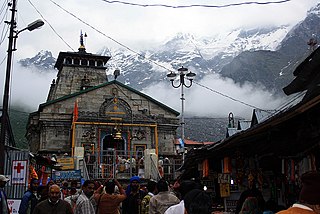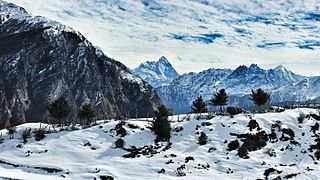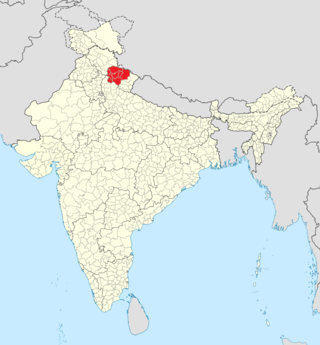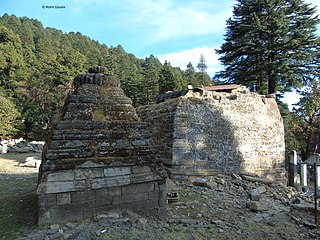Related Research Articles

Garhwal is one of the two administrative divisions of the Indian state of Uttarakhand. Lying in the Himalayas, it is bounded on the north by Tibet, on the east by Kumaon, on the south by Uttar Pradesh state, and on the northwest by Himachal Pradesh state. It includes the districts of Chamoli, Dehradun, Haridwar, Pauri Garhwal, Rudraprayag, Tehri Garhwal, and Uttarkashi. The people of Garhwal are known as Garhwali and speak the Garhwali language. The administrative center for Garhwal division is the town of Pauri. The Divisional Commissioner is the administrative head of the Division, and is a senior Indian Administrative Service officer. As the administrative head of the division, the Commissioner is overall incharge of the 7 districts in the Garhwal region of Uttarakhand, and is aided in his duties by an additional commissioner and the district magistrates. Sushil Kumar is the divisional commissioner of the Garhwal Division since December 2021.

The folk music of Uttarakhand refers to the traditional and contemporary songs of Kumaon and Garhwal regions in the foothills of Himalayas. This music has its root in nature and the hilly terrain of the region.

Uttarakhand, formerly known as Uttaranchal, is a state in northern India. The state is bordered by Himachal Pradesh to the northwest, Tibet to the north, Nepal to the east, Uttar Pradesh to the south and southeast, with a small part touching Haryana in the west. Uttarakhand has a total area of 53,566 km2 (20,682 sq mi), equal to 1.6 per cent of the total area of India. Dehradun serves as the state capital, with Nainital being the judicial capital. The state is divided into two divisions, Garhwal and Kumaon, with a total of 13 districts. The forest cover in the state is 45.4 per cent of the state's geographical area. The cultivable area is 16 per cent of the total geographical area. The two major rivers of the state, the Ganges and its tributary Yamuna, originate from the Gangotri and Yamunotri glaciers respectively.

Chamoli district is a district of the Uttarakhand state of India. It is bounded by the Tibet region to the north, and by the Uttarakhand districts of Pithoragarh and Bageshwar to the east, Almora to the south, Pauri Garhwal to the southwest, Rudraprayag to the west, and Uttarkashi to the northwest. The administrative headquarters of Chamoli district is in Gopeshwar.

Kumaoni is an Indo-Aryan language spoken by over two million people of the Kumaon region of the state of Uttarakhand in northern India and parts of Doti region in Western Nepal. As per 1961 survey there were 1,030,254 Kumaoni speakers in India. The number of speakers increased to 2.2 million in 2011.

Garhwali is an Indo-Aryan language of the Central Pahari subgroup. It is primarily spoken by over 2.5 million Garhwali people in the Garhwal region of the northern Indian state of Uttarakhand in the Indian Himalayas.

Pauri Garhwal is a district in the Indian state of Uttarakhand. Its headquarters is in the town of Pauri. It is sometimes referred to simply as Garhwal district, though it should not be confused with the larger Garhwal region of which it is only a part of.

Gauchar is a Hill Town sort of a valley town located in Karnaprayag tehsil within Chamoli district of Uttarakhand state in India. Gauchar is situated on the left bank of river Alaknanda and is en route to the celebrated holy destination of Badrinath. It is well known for being one of the cleanest place in country. It has previously topped Swachta sarvekshan best ganga town award. Situated at an altitude of 800 metres (2,620 ft) above the sea level, Gauchar is surrounded by seven mountains. Gauchar is well known for its historic trade fair and airstrip. Gauchar town known for its great work to curb loss of lives in 2013 flood disaster of Uttarakhand. This town is unique in terms of its geographical location and topography. Gauchar is located on one of the largest pieces of flatland in this mountainous region of Uttarakhand. Education institution in Gauchar includes a beautiful Kendriya Vidyalaya adjacent to the main playground.

Badarinath or Badarinarayana Temple is a Hindu temple dedicated to Vishnu. It is situated in the town of Badrinath in Uttarakhand, India. The temple is also one of the 108 Divya Desams dedicated to Vishnu—holy shrines for Vaishnavas—who is worshipped as Badrinath. It is open for six months every year, because of extreme weather conditions in the Himalayan region. The temple is located in Garhwal hill tracks in Chamoli district along the banks of Alaknanda River. It is one of the most visited pilgrimage centers of India, having recorded 2.8 million visits in just 2 months in 2022. It is one of the Char Dham pilgrimage sites.

Kedarnath Temple is a Hindu temple, one of the twelve jyotirlinga of Shiva. The temple is located on the Garhwal Himalayan range near the Mandakini river, in the state of Uttarakhand, India. Due to extreme weather conditions, the temple is open to the general public only between the months of April and November. During the winters, the vigraha (deity) of the temple is carried down to Ukhimath to be worshipped for the next six months. Kedarnath is seen as a homogeneous form of Shiva, the 'Lord of Kedarkhand', the historical name of the region.

The Garhwali people are an Indian ethnolinguistic group native to the Garhwal, in the Indian state of Uttarakhand, who speak Garhwali, an Indo-Aryan language.
Jagar is a Hindu form of Shamanism which is practiced in the hills of Uttarakhand, both in Garhwal and Kumaon. As a ritual, Jagar is a way in which gods and local deities are woken from their dormant stage and asked for favors or remedies. The ritual is connected to the idea of divine justice and is practiced to seek penance for a crime or to seek justice from the gods for some injustice. The word Jagar comes from the Sanskrit root, Jaga, meaning "to wake".
The mashak is a type of bagpipe found in Northern India, Uttarakhand, Sudurpaschim Province of Nepal and parts of Pakistan and Afghanistan. The pipe was associated with weddings and festive occasions. In India it is historically found in Kumaon and Garhwal in Uttarakhand, Rajasthan and Uttar Pradesh. This bagpipe uses single reeds, and can be played either as a drone or as a melody instrument.
Uttarakhand is a state in the northern part of India. It is often referred to as the "Devbhumi" due to its religious significance and numerous Hindu temples and pilgrimage sites found throughout the state. As a result, religious tourism forms a major portion of the tourism in the state. Uttarakhand is known for the natural environment of the Himalayas. 2019 Tourist Arrivals Domestic – 40,000,000 per/year and Foreigner – 150,000 per year. Tourism business in Uttarakhand generated ₹ 23,000 crores during 2013–14.

Ramman is a religious festival and ritual theatre of the Garhwal region in India. It is a festival of the Garhwali People celebrated in many villages of the region. Although there are many Rammans, such as the Jak Ramman, one of the most popular is the masked Ramman of the Saloor Dungra village of the Painkhanda Valley in the Chamoli district in Uttarakhand, India.

Thalisain is a town and tehsil of Pauri Garhwal district in the North Indian state of Uttarakhand. At an elevation of 1690 metres from sea level, it is situated on a gentle slope above the right bank of Nayaar (East) river. It is in the southwestern foothills of Dudhatoli Range and at a distance of 83 kilometers from Pauri town and 95 kilometers from Gairsain, the future capital of Uttarakhand.
Chander Singh Rahi was a prominent folk singer, balladeer, musician, poet, storyteller, and cultural conservator from Uttarakhand, India.

Dhol Sagar is an ancient Indian treatise on the art of playing the dhol damau, the folk instruments of the Garhwal region of Uttarakhand. It does not exist in a complete printed form, as it was transmitted orally or empirically within the traditional drumming families. It is believed to have mythical origins and its existence has only been confirmed by local scholars and practitioners.
Pandav Lila or Pandav Nritya is a ritual re-enactment of stories from the Hindu epic Mahabharata, through singing, dancing and recitation, that is practised in the Garhwal region of Uttarakhand, India. Pandavas are the five protagonists in the epic and the village amateurs take on their roles and perform the lila outdoors, accompanied by the folk instruments dhol, damau and two long trumpets called bhankore. The performances, which can last anywhere from three days to a month in different villages, draw large crowds and are an important cultural highlight of the year. The ritualistic drama features actors who often spontaneously become "possessed" by the spirits of their characters and begin to dance.
Dhol damau or dhol damaun is the term used to collectively refer to two folk instruments of Uttarakhand and lower Himachal Pradesh, the dhol and damau, which are almost always played together on special occasions; though they may be played separately. The two instruments play a vital role in the lives of villagers, who often live in remote valleys of the region, and every important event is accompanied by their playing, which is considered auspicious. They are played according to the ancient oral treatise of Dhol Sagar that lists specific rhythmic patterns for every occasion, from celebrating birth and christening to religious ceremonies, folk dramas like Pandav Lila, and death rituals. Traditionally, they have been played by specific caste groups like auji, bajgi, das or dholi.
References
- ↑ Fiol, Stefan (11 September 2017). Recasting Folk in the Himalayas: Indian Music, Media, and Social Mobility. University of Illinois Press. ISBN 9780252099786 – via Google Books.
- ↑ "Bhankora an Aero Phonic or Wind Musical Instrument used in Religious Garhwal Folk Dramas » Bedupako.com™". bedupako.com. Archived from the original on 30 September 2015. Retrieved 29 September 2015.
- ↑ Alter, Andrew (1 April 2011). "Controlling Time in Epic Performances: An Examination of Mahābhārata Performance in the Central Himalayas and Indonesia.Bhankora an Aero Phonic or Wind Musical Instrument in Garhwali Folk Drama, Folk Rituals, Community Theaters and Traditional Plays from Chamoli Garhwal, North India, South Asia". Ethnomusicology Forum. 20 (1): 57–78. doi:10.1080/17411912.2011.549362. S2CID 193246028.